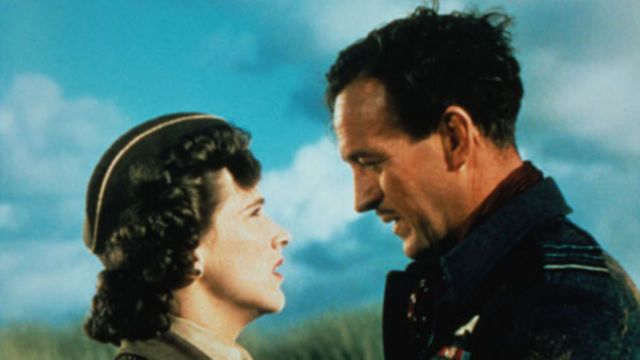A Matter of Life and Death (1946) 
“A motion picture beyond all wonder!”

Director: Michael Powell, Emeric Pressburger
Cast: David Niven, Kim Hunter, Robert Coote
Synopsis: A British wartime aviator who cheats death must argue for his life before a celestial court.
There was something undeniably original about the team of Michael Powell and Emeric Pressburger that set them apart from all other filmmakers on both sides of the Atlantic. They had a visual flair and an unbridled imagination which made their movies these great, unpredictable adventures, and A Matter of Life and Death is possibly one of their most innovative works in terms of invention. It positively teems with ideas and energy and has an exhilarating disregard for convention, while at the same time exploring serious issues such as prejudice and xenophobia.
David Niven plays Peter Carter, an RAF pilot during WWII, who finds himself alone and without a parachute in a plane that’s about to plunge into the sea. He briefly makes radio contact with June (Kim Hunter), an American WAC at an English air base, and they instantly connect. Deciding to jump from the plane rather than burn with it, Peter says his farewells to June. He later awakens on a deserted beach. Initially believing himself to be in heaven, he slowly realises he has somehow survived the fall from the airplane and runs into June as she is cycling home after taking his SOS call. The couple instantly fall in love.
In heaven, however, Conductor 71 (Marius Goring) realises that he is one new arrival short. Carter should have arrived with the rest of his crew but was somehow overlooked. When he visits earth to claim Peter, the young pilot refuses to go back with him, and demands an appeal as he and June only met because of heaven’s mistake, and should therefore be allowed to live out their lives together. The Conductor leaves to confer with his superiors, and while he is away June arranges for Peter to meet Doctor Reeves (Roger Livesey) for treatment for the blinding headaches that have plagued him since the fall. Reeves suspects Peter is suffering from a brain tumour, which may be the reason he keeps meeting the celestial figure of Conductor 71.
The towering ambition of Powell and Pressburger is apparent in every frame of A Matter of Life and Death. The colours are vibrant, almost saturated, and Jack Cardiff’s camera is often invited to focus intently on the story’s protagonists, filming in tight close ups on their faces. Perversely, they chose to shoot heavenly scenes in black-and-white while those on earth are shot in colour — ‘One is starved for Technicolor up there,’ the conductor wryly comments on one of his earthly visits — but what heaven lacks in colour it makes up for in scale with massive sets which, while quite obviously fake, must have looked mightily impressive back in 1946. One shot, near the end of the movie, pulls back from a vast amptitheatre to reveal a rolling landscape, and then continues to pull back to reveal that we are actually looking at a massive supernova deep in space. It’s a shot that still looks pretty impressive today so it must have blown audiences away in a time when special effects usually still came with all strings visibly attached. The giant stairway to heaven (Stairway to Heaven was the US title) is also breathtaking in its scale and grandeur. But, Powell and Pressburger didn’t just confine themselves to the big stuff: in another startling POV shot we see Peter Carter’s eyelid, complete with tiny veins, sliding slowly shut over his eye.
David Niven is the epitome of the dashing young RAF airman, and while his enthusiastic performance might look a little dated at times — and even back then he could possibly have benefited from a little more restraint in the emotional scenes — he’s more than ably assisted by the then-unknown Kim Hunter who gives a quietly assured performance as his love interest. Roger Livesey also gives a winning performance as Doctor Reeves, one of those quietly authoritative figures who always seems to be right. Lastly, Raymond Massey makes a late appearance in the famed Heavenly Trial sequence as Abraham Farlan, the first American shot by the British during the War of Independence, and gives an impressively forceful performance.
A Matter of Life and Death is one of only a few films that has come through nearly seventy years still looking nearly as fresh as it must have back when it was first released, and has outgrown its humble origins as a wartime propaganda piece intended to encourage Anglo-American co-operation to become one of cinema’s greatest romantic fantasies.
(Reviewed 2nd May 2013)
httpv://www.youtube.com/watch?v=VUlUrh5zKH8
